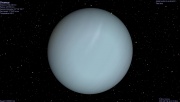Planetary Database/Terran/Uranus
The Planetary Database - Terran System - Uranus
Discovery
Uranus was the first planet to be discovered that was not known in ancient times; although it had been observed on many previous occasions, it was always mistakenly identified as a star. The earliest recorded sighting was in 1690 when John Flamsteed catalogued Uranus as 34 Tauri. Flamsteed observed Uranus at least six more times. The record belongs to a French astronomer, Pierre Lemonnier, who observed Uranus at least twelve times between 1750 and 1771, including on four consecutive nights.
Sir William Herschel formally discovered the planet on March 13, 1781, but reported it on April 26, 1781, as a "comet."
Herschel originally named it Georgium Sidus (George's Star) in honour of King George III of Great Britain. When it was pointed out that sidus means star and not planet, he rebaptised it the Georgian Planet. This name was not acceptable outside of Britain. Lalande proposed in 1784 to name it Herschel, at the same time that he created the planet's symbol ("a globe surmounted by your initial"); his proposal was readily adopted by French astronomers. Prosperin, of Uppsala, proposed the names Astraea, Cybele, and Neptune (now borne by two asteroids and a planet). Lexell, of St. Petersburg, compromised with George III's Neptune and Great-Britain's Neptune. Bernoulli, from Berlin, suggested Hypercronius and Transaturnis. Lichtenberg, from Göttingen, chimed in with Austräa, a goddess mentioned by Ovid (but who is traditionally associated with Virgo). The name Minerva was also proposed.
Physical characteristics [edit]
Composition
Uranus is composed primarily of gas and various ices. The atmosphere is about 85% hydrogen, 15% helium and traces of methane, while the interior is richer in heavier elements, most likely compounds of oxygen, carbon, and nitrogen, as well as rocky materials. This is in contrast to Jupiter and Saturn which are mostly hydrogen and helium. Uranus (like Neptune) is very much similar to the cores of Jupiter and Saturn without the massive fluid metallic hydrogen envelope. Uranus' cyan color is due to the absorption of red light by atmospheric methane. Surface temperature on Uranus's cloud cover is approximately 55 K (−218 °C or −360 °F).
Axial tilt
One of the most distinctive features of Uranus is its axial tilt of ninety-eight degrees. Consequently, for part of its orbit one pole faces the Sun continually while the other pole faces away. At the other side of Uranus' orbit the orientation of the poles towards the Sun is reversed. Between these two extremes of its orbit the Sun rises and sets around the equator normally.
At the time of Voyager 2's passage in 1986, Uranus' south pole was pointed almost directly at the Sun. Note that the labelling of this pole as "south" is actually in some dispute. Uranus can either be described as having an axial tilt of slightly more than 90°, or it can be described as having an axial tilt of slightly less than 90° and rotating in a retrograde direction; these two descriptions are exactly equivalent as physical descriptions of the planet but result in different definitions of which pole is the North Pole and which is the South Pole.
One result of this orientation is that the polar regions of Uranus receive a greater energy input from the Sun than its equatorial regions. Uranus is nevertheless hotter at its equator than at its poles, although the underlying mechanism which causes this is unknown. The reason for Uranus' extreme axial tilt is also not known. It is speculated[citation needed] that perhaps during the formation of the planet it collided with an enormous protoplanet, resulting in the skewed orientation.
It appears that Uranus' extreme axial tilt also results in extreme seasonal variations in its weather. During the Voyager 2 flyby, Uranus' banded cloud patterns were extremely bland and faint. Hubble Space Telescope observations, however, show a more strongly banded appearance now that the Sun is approaching Uranus' equator. By 2007 the Sun will be directly over Uranus's equator.